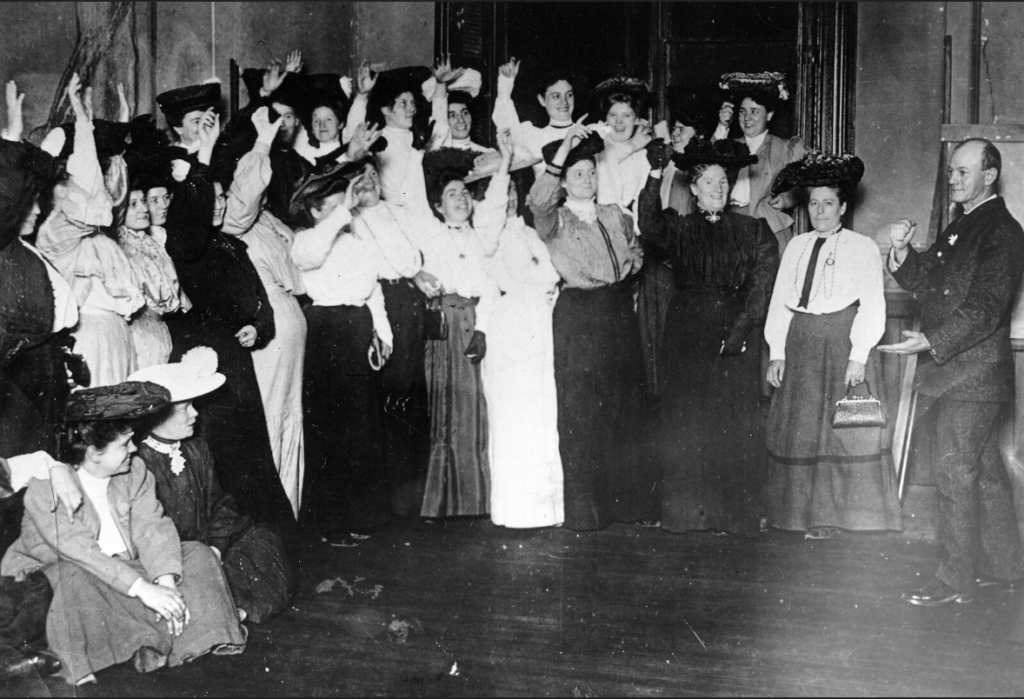
Cornell University Library is licensed under Creative Commons license CC-BY-2.0.
Their strike, which became known as the Philadelphia Shirtwaist Strike, drew national attention to the dangers workers faced in a rapidly industrializing society.
The strike derived its name from the shirtwaist, a style of blouse designed to resemble a men’s shirt that was popular in the early 20th century. They were mainly sewn by young women and children, many of whom were immigrants, in sweatshops and factories.
“It’s hard to overstate how terrible the conditions were in the factory,” said Rebecca Davis, professor of history at the University of Delaware. “We have to remember that this is taking place before any of the labor legislation that we all take for granted.”
Fire escapes were locked due to fears of workers stealing fabric. Days could be as long as 14 hours, and the work week was six days long. There were few sanitary facilities for when workers needed to relieve themselves. Spaces were crowded and hot in the summer and freezing in the winter. Children as young as 10 worked alongside young women in their teens and early 20s.
An anonymous editorial published in the Jewish Exponent detailed the exploitation workers experienced in Philadelphia’s garment factories, including the owners’ lack of liability for unsafe working conditions and low wages that were often paid late.
“The average salary of the most skilled operator is not more than $6 a week when it is considered that sometimes for three months at a time there is no work to be had,” the contributor wrote. “If she wants to leave the shop for a time she is refused permission. She makes a dollar perhaps after waiting all day; or fifty cents. The price paid these girls is pitiful.”
Workers were also expected to buy their own sewing equipment and many were sexually harassed and assaulted by male managers.
The strike began on Dec. 20, 1909, when garment workers in Philadelphia realized a recent influx of work was due to factory owners in New York City outsourcing manufacturing in response to a shirtwaist strike there. This protest would later become known as the Uprising of the 20,000 after the number of workers who participated.
Workers in Philadelphia decided to strike after representatives from New York encouraged them to join the cause, according to Julianne Kornacki, author of “Revealing Division: The Philadelphia Shirtwaist Strike, the Jewish Community, and Republican Machine Politics, 1909–1910.”
They demanded an increase in wages, regular and consistent payment, a 50-hour work week, sanitary working conditions, union recognition and free work materials like needles and thread. They also issued an informal demand for freedom from workplace harassment.
Approximately 85% percent of the 7,000 shirtwaist strikers were Jewish women and girls who had immigrated from Russia. Davis said they were encouraged to work outside the home more than women from other immigrant groups, since Eastern European Jewish tradition dictated that men dedicate themselves to studying Torah while women worked in the secular world to support their families.
Wealthy social reformers and college students provided material support for the strike, including food, meeting places and bail money. The International Ladies Garment Workers Union and the Women’s Trade Union League sent representatives and solicited support, and local unions pledged solidarity.
Davis said the city government and business community were staunchly opposed to the cause. Strikers faced arrest and beatings from police and harassment from the general public. They also faced resistance from within the Philadelphia Jewish community, as many of the factory owners were wealthy Jews whose families had immigrated to the United States from Germany two or three generations previously.
The women even faced sexism from men who joined their cause. Daniel Sidorick, a labor studies lecturer at Rutgers University-New Brunswick, said many male union leaders did not believe that the female workers were capable of sustaining the strike. When Abraham Rosenberg, president of the ILGWU, urged the women to agree to arbitration even as their employers refused to recognize their union, the meeting hall erupted in anger and the workers returned to the picket lines. The strike finally ended on Feb. 5, 1910.
Representatives from the Universal Peace Union, who had joined the cause and enlisted the support of President William Taft’s daughter Helen, solicited a letter from the president calling for the strike to be settled. Both sides offered concessions, but the strikers obtained their demands of a shortened work week, increased wages, an end to charges for supplies and union recognition.
“It was important because it was the first really large case of women workers going on strike in such massive numbers,” Sidorick said. “It was really transformative to the young women that took part in it. It really changed many of their lives.”
[email protected]; 215-832-0729
"strike" - Google News
March 18, 2021 at 11:17PM
https://ift.tt/3c27Jtu
Women's History Month: Remembering the Philadelphia Shirtwaist Strike of 1909 - Jewish Exponent
"strike" - Google News
https://ift.tt/2WheuPk
https://ift.tt/2VWImBB
Bagikan Berita Ini














0 Response to "Women's History Month: Remembering the Philadelphia Shirtwaist Strike of 1909 - Jewish Exponent"
Post a Comment